The AMD 3rd Gen Ryzen Deep Dive Review: 3700X and 3900X Raising The Bar
by Andrei Frumusanu & Gavin Bonshor on July 7, 2019 9:00 AM EST** = Old results marked were performed with the original BIOS & boost behaviour as published on 7/7.
Benchmarking Performance: CPU Rendering Tests
Rendering is often a key target for processor workloads, lending itself to a professional environment. It comes in different formats as well, from 3D rendering through rasterization, such as games, or by ray tracing, and invokes the ability of the software to manage meshes, textures, collisions, aliasing, physics (in animations), and discarding unnecessary work. Most renderers offer CPU code paths, while a few use GPUs and select environments use FPGAs or dedicated ASICs. For big studios however, CPUs are still the hardware of choice.
All of our benchmark results can also be found in our benchmark engine, Bench.
Corona 1.3: Performance Render
An advanced performance based renderer for software such as 3ds Max and Cinema 4D, the Corona benchmark renders a generated scene as a standard under its 1.3 software version. Normally the GUI implementation of the benchmark shows the scene being built, and allows the user to upload the result as a ‘time to complete’.
We got in contact with the developer who gave us a command line version of the benchmark that does a direct output of results. Rather than reporting time, we report the average number of rays per second across six runs, as the performance scaling of a result per unit time is typically visually easier to understand.
The Corona benchmark website can be found at https://corona-renderer.com/benchmark
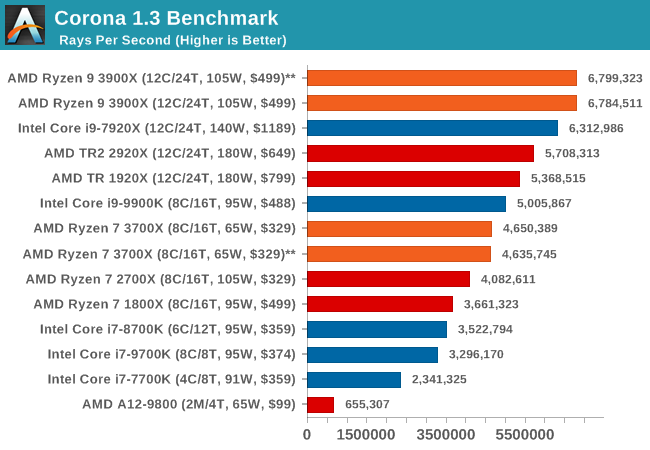
LuxMark v3.1: LuxRender via Different Code Paths
As stated at the top, there are many different ways to process rendering data: CPU, GPU, Accelerator, and others. On top of that, there are many frameworks and APIs in which to program, depending on how the software will be used. LuxMark, a benchmark developed using the LuxRender engine, offers several different scenes and APIs.

Taken from the Linux Version of LuxMark
In our test, we run the simple ‘Ball’ scene on both the C++ and OpenCL code paths, but in CPU mode. This scene starts with a rough render and slowly improves the quality over two minutes, giving a final result in what is essentially an average ‘kilorays per second’.

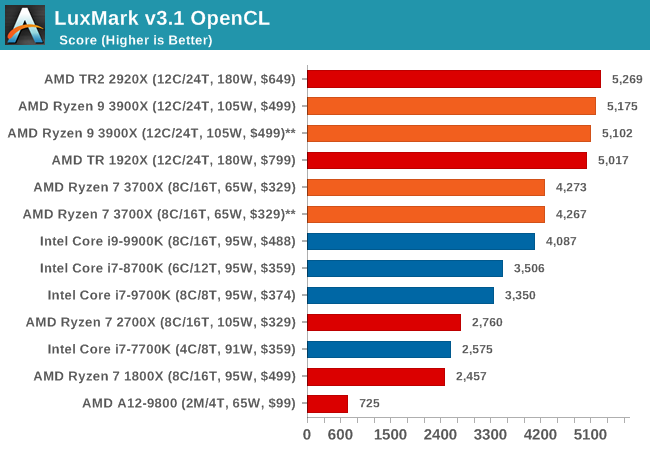
POV-Ray 3.7.1: Ray Tracing
The Persistence of Vision ray tracing engine is another well-known benchmarking tool, which was in a state of relative hibernation until AMD released its Zen processors, to which suddenly both Intel and AMD were submitting code to the main branch of the open source project. For our test, we use the built-in benchmark for all-cores, called from the command line.
POV-Ray can be downloaded from http://www.povray.org/
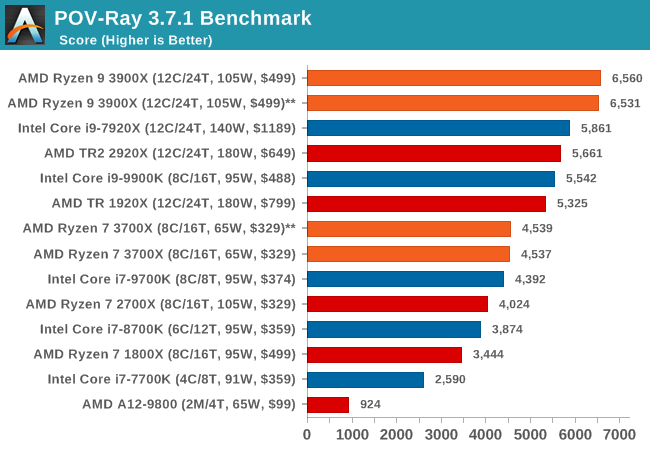
Cinebench R15
The latest version of CineBench has also become one of those 'used everywhere' benchmarks, particularly as an indicator of single thread performance. High IPC and high frequency gives performance in ST, whereas having good scaling and many cores is where the MT test wins out.
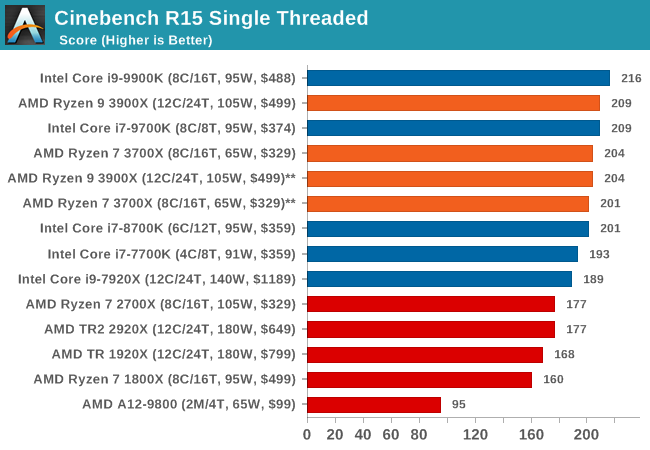
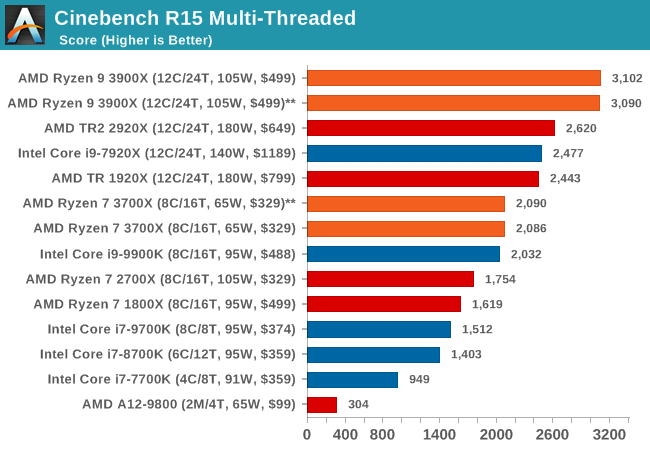











447 Comments
View All Comments
Korguz - Monday, July 8, 2019 - link
huh ???mkozakewich - Saturday, July 13, 2019 - link
"...as unfortunately the timing didn’t work out."You should increase his voltage a little and reboot, that might help.
Meteor2 - Monday, July 15, 2019 - link
It's hard to get one's head around this, but basically: *all* the Intel benchmarks *do not* include the security patches for the MDS-class flaws. The 9000 and 8000 series tests do include the OS-side Spectre fixes, but that's it. No OS-fixes for other CPUs, and no motherboard firmware fixes for any Intel CPUsAt the very least, all the Intel CPUs should be retested on Windows 10 1903 which has the OS-side MDS fixes.
Most if not all the motherboards used for the Intel reviews can also have their firmware upgraded to fix Spectre and most times MDS flaws. Do it.
This is sensible and reasonable to do: no sensible and reasonable user would leave their OS vulnerable. Maybe the motherboard, because it's a bit scary to do, but as that can be patched, it should be by reviewers.
This would result in all the Intel scores being lower. We don't know by how much without this process actually being done. But until it is, the Intel results, and thus the review itself, are invalid.
While you're at it Anandtech, each year buy the latest $999 GPU for CPU testing. Consider it a cost of doing business. Letting the GPU bottleneck the CPU on most game resolutions benchmarked is pointless.
plonk420 - Sunday, July 7, 2019 - link
mountain time zone, best time zone... 7am 7/7!exactopposite - Sunday, July 7, 2019 - link
Been waiting on this one for a long timeEris_Floralia - Sunday, July 7, 2019 - link
It's really nice to see Andrei starting to take part in desktop processor reviews and Gavin Bonshor's hardwork!mjz_5 - Sunday, July 7, 2019 - link
Intel gets 5% better FPS In games is really not a win. I’ll consider that a tie. In multiple applications AMD gets 20% more performance. That’s a win!!Dragonstongue - Sunday, July 7, 2019 - link
hopefully Anal lists :P see how much a "win" the Ryzen 3k / x5xx / Navi truly are, not only to get AMD margins even higher but to take more market share from Intel and "stagnate" Nvidia's needing to "up the price" to make more $$$$$$ when AMD "seems" to be making "as much if not more" selling a small amount less per unit (keep in mind, AMD is next Playstation and Xbox which are 99/9% likely to be using the same silicon, so, AMD take a "small hit" to get as many Ryzen gen 3 and Navi "in the world" which drums up market/mindshare which is extremely important for any business, at this stage in the game is VITAL for AMD.sor - Sunday, July 7, 2019 - link
I’m honestly wondering what the point is of the gaming benchmarks for CPU tests anymore.It seems like the game is either so easy to render that we are comparing values in the hundreds of FPS, or they’re so hard to render that it’s completely GPU dependent and the graph is flat for all CPUs.
In the vast majority of tests here one would have an identical experience with any of the top four CPUs tested.
Targon - Monday, July 8, 2019 - link
Game engines are starting to use more cores, and at lower resolutions(which do not stress the video card all that much) will show improvements/benefits of using one CPU or even platform over another. In this review, due to the RAM being used, the gaming benchmarks are almost invalid(DDR4-3200 CL16), since moving to CL14 RAM would potentially eliminate any advantage Intel has in these benchmarks.